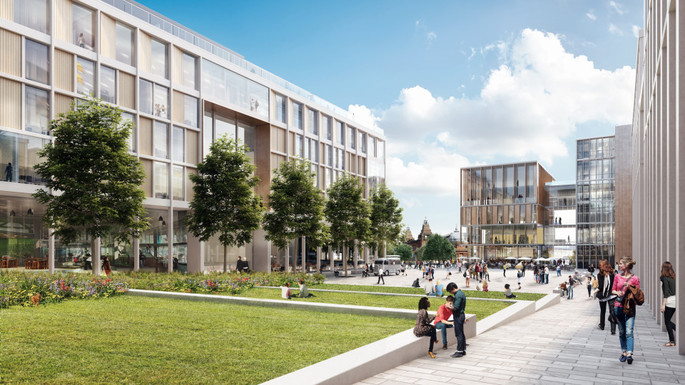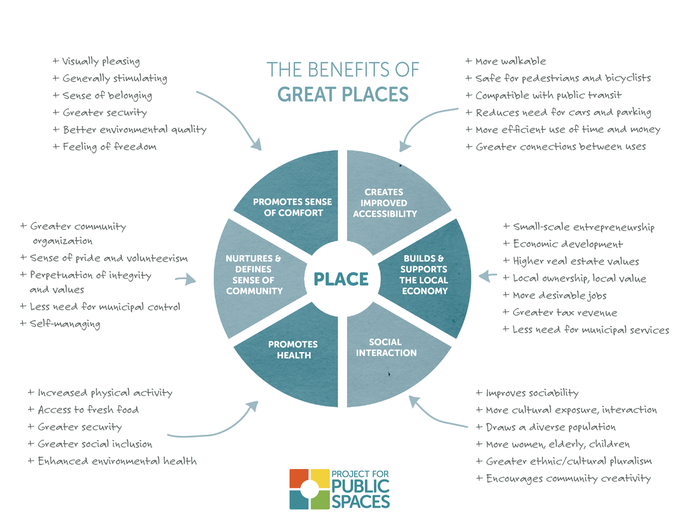Placemaking and the University – opening the university to the community
Capital spending by universities on expanding and improving their estates is high just now as they seek to secure their position in the global higher education market place and attract ‘high value’ staff and students. Often such developments are essentially ‘estates driven’, institutions ever mindful of the returns to the institution to be expected from their investment. At the same time, many universities are important anchors for the cities and regions in which they are located, and major university re-developments have implications for their host communities in terms of increasing economic opportunities and for the social and cultural amenities which enrich the quality of civic life. Whilst the economic impact of universities to cities and regions are well researched and usually substantial, less attention has been paid to the social, cultural and learning impacts which accrue to the community.
This paper offers a perspective on the latter. Major university developments can impact significantly on the physical features of a city, and indeed can be disruptive in the construction phase. They also have the potential to significantly change the character of the neighbourhood in which the development is located. They can create new spaces and places and change the face the university presents to its host community. Universities, in taking forward major developments are in the placemaking business. Here we explore the insights a placemaking perspective can bring to university re-development, taking as an example, the new large-scale development shortly to be undertaken by Glasgow University.
Placemaking
Placemaking is not a new idea. It draws on the writings of people such as Jane Jacobs and William H. Whyte on the importance of designing cities first and foremost for people. Their work is focussed on the social and cultural importance of lively neighbourhoods and vibrant public spaces.
Placemaking is both a philosophy and a process. It is predicated on an approach around observing, listening to and asking questions of people who live, work and play in a space to build an understanding and common vision of the needs and aspirations for that space and for the wider community in which it is situated.
A place is a space with meaning, a destination with purpose. It has been shown that a strong sense of place influences the physical, social and emotional health of individuals and communities. Great places foster social networks, and build social capital in ways which benefit multiple stakeholders in the community.
The new Glasgow University development
Expectations are high for the new large-scale re-development in the West End of Glasgow. As well as providing for the re-location of several University schools, a major feature of the development is the creation of a new civic square, open to the public. The University intends to create a space that the city and the West End can be proud of. It is envisaged that the space will open the university to the whole community, and along with the re-imagined Kelvin Hall, provide the city with a vibrant cultural place.

This is what the proposed public square might look like. How to realise the aspirations above and turn this space into a public place with meaning and purpose is the placemaking challenge.
Meaning and purpose will be grounded in stakeholder views and expectations. There are many stakeholders in this development, including not only the university and its staff and students, but also the city authorities, local businesses, the local community, visitors and tourists and more. There are also many purposes the place could fulfil, some of them already articulated in the expectations cited above. These include a place for social interaction, a place to 'open up' the university and encourage people to engage with it and with learning, a place to complement existing local facilities, a place for entertainment, a place for appreciation of culture and heritage. No doubt more could be identified, and the above list can be refined further.
The challenge is to develop the new physical space as a multi-use destination to which people, both in the University and in the community, have an emotional attachment, and feel connected and safe.
The placemaking approach
The approach to building a great place needs to be comprehensive, including both 'top-down' and 'bottom-up’ strategies. Success will depend on establishing both good relations with communities and stakeholders in the planning stages and in creative outreach strategies as the development takes shape and becomes available for use.
The principles for effective placemaking have been clearly articulated. They include:
- Recognising the community is the expert;
- It is a place, not a design;
- Placemaking requires partners;
- Strong and committed stewardship;
- Based on observation and listening;
- Based on a shared vision;
- Triangulation for multi-uses;
Using these principles, a new public space can evolve into a community place which strengthens the social fabric of the community in which it is located. In so doing it can foster local economic development and innovation and promote healthy, sustainable living. Building 'place capital' in this way can leverage a wide range of goals. Working closely alongside the development process, a placemaking approach will influence the design of the square, the facilities it offers, and the buildings around it to support the vision for the new place.
The significance of university-based places
There are numerous examples of how spaces such as streets, parks, unused land below urban flyovers and other underused sites have been transformed into meaningful places for community benefit. The benefits of great places have been neatly summarised in the diagram below. Whilst this range of benefits remains highly pertinent in the context of a university-based development, it is appropriate to keep it under review. University developments such as that planned in Glasgow have an explicit intention of bringing the university closer to the community and re-cast the boundaries between the institution and its locality. Such university-based development might be seen as an attempt to create a qualitatively different kind of place – a ‘learning place’ with an emphasis on promoting participation in, and the benefits of learning.

This re-conceptualisation of a ‘learning place’ needs to be explored further. Some suggestions are made below to clarify what a general intention of ‘opening-up’ the university might mean. The list might include:
- Promoting an understanding in the community of the scope of the university’s contribution to knowledge;
- Boosting the visibility of the university’s contribution to the local city region;
- Encouraging participation in learning in the community;
- Widening access to learning opportunities for the community;
- Extending and complementing economic opportunities in the surrounding area;
- Blending ideas for innovation from local agencies and businesses with university expertise;
- Facilitating discussion and exchange between members of the university community and the wider community and visiting place users;
- Allowing the university to better appreciate and respond to learning needs within the community and city region.
It can be argued that many Universities are already significant places within their host cities. Universities may already occupy substantial buildings with an imposing physical presence. Many have cloisters and other spaces within them which provide opportunities for informal exchanges between members of the university community, and some encourage members of local communities and visitors to use resources such as galleries, museums and theatres. Universities often constitute a major part of the cultural heritage of a city and region.
University-based placemaking through new major developments is thus an opportunity to add extra dimensions to an already existing place. It may provide a challenge to the typical management practices in the university. It requires the university not so much to design a place for the community as to join with the community and its range of local stakeholders to co-design a space which will facilitate an agreed range of purposes which will give the space a real meaning for the university, its neighbourhood and the wider city.
The ‘learning place’ should complement what is already available and inspire and facilitate participation in learning, both formal and informal. It could open the way into exhibition spaces for university researchers to demonstrate the work they are doing. It could provide informal meeting spaces and presentation or performance spaces. It could provide guides on access to museum resources or to university public lectures, seminars and discussions. It could provide facilities to encourage communities to articulate and explore their own issues and innovative ideas. It could provide locations for relaxation, health and fitness, and informal exchange over a meal and a drink. The list is potentially long, but the essential point is that its content should be the result of a collaborative, partnership approach between the university and its host community and stakeholders. This could lead to a pooling of community resources to enhance both the university and the locality still further, and change the seemingly sometimes rather remote relationship between the university and its hosts.
Learning places in a learning city
Universities act on a global and national stage as well as on a local one. Whilst they need to secure a position amongst the competition on the world stage, arguably that will only be strengthened if the University can demonstrate its strong, and shared, relationship with its host city and community. A learning city is now recognised as one which promotes learning for all sections of its population, between businesses and in its governance and provision of services. Such an approach benefits the economic well-being of the city and the health and well-being of its people. It helps the city better adapt to the major challenges cities face in adapting to social and demographic change and to climate change and the environment. Universities and colleges have a significant part to play in a learning city. University-based placemaking, as explored here can add to that contribution. The new public learning place, developed on placemaking principles, can be a valuable community and civic place which can also act to sustain the University’s community foundations and enhance its civic standing.
 Printer-friendly version
Printer-friendly version- Login to post comments







